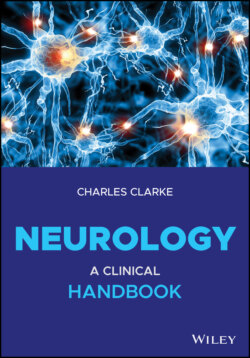Читать книгу Neurology - Charles H. Clarke - Страница 35
Basal Ganglia Circuits
ОглавлениеNeuronal servo‐loops commence and end in the motor cortex. All pass through the striatum (putamen + caudate nucleus) and return via the thalamus, and within each loop there are two pathways: direct and indirect.
Transmission through each loop is controlled via the pars compacta of the substantia nigra to the lateral globus pallidus, where axons make two principal types of synapse, on excitatory D1 (dopaminergic, direct pathway) and inhibitory D2 (indirect pathway) receptors. Further receptors are now recognised in the D receptor series.
In normal subjects, the nigro‐striatal tract is active, selecting preferentially the excitatory, direct pathway and thus leading, via the loop back to the cortex to activation of the supplementary motor area before a movement, and thence to a movement itself (Figure 2.4). This early activation of the cortex underlies the electrical readiness potential (Bereitschaftspotential).
Such servo‐loops modulate, for example:
Cognition/motor intention, contraction strength, suppression, speed control, storage of programmes
Limbic (memory) loop: cortex→nucleus accumbens→ventral pallidum→thalamus→cortex.
